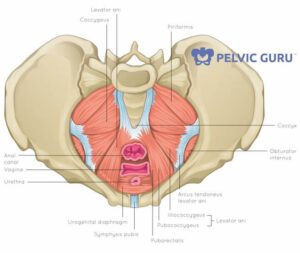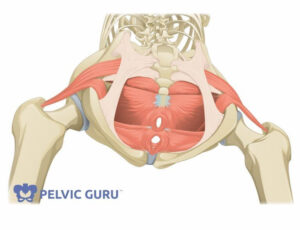
Many patients first come to see me not knowing what their pelvic floor even is. However, many people, even men, have heard of Kegel exercises. I bet you had heard of Kegel exercises before even choosing to read this post.
Because they are so popular, many people immediately look into Kegel exercises and think they need to strengthen their pelvic floor before they even make it to their appointment. This is a common misconception, and in fact, strengthening is least likely to be the solution to your concern. Now before I go too far on my soapbox, let me give you some background on Kegel exercises.
ABOUT KEGEL EXERCISES
Dr. Kegel was a physician who discovered the pelvic floor muscles. He first published his findings in 1948, to address pelvic floor dysfunction he had people tighten and relax these muscles. Fast forward to the present, and Kegel exercises have become the cure-all for pelvic floor problems!
You may be familiar with the “you must be tight” idea, as popular marketing encourages you to stop the flow of urine (DON’T DO THAT, it can cause infection), hold in your toots, tighten at every stoplight, squeeze around your partner’s member, or even lift your testicles to stop incontinence. There are weights, apps, balloons, and sticks galore that all help target these muscles promising a better core, stronger orgasms, and no more leaking.
Please, I am begging you to STOP assuming that Kegel exercises solve everything. We have learned so much more about the pelvic floor since 1948 people, I promise! Most of the time Kegel exercises are not what you actually need for improvement.
Seek out a pelvic floor physical therapist who can provide you with a full examination and discover the true nature of your concerns.
HOW KEGEL EXERCISES AFFECT THE PELVIC FLOOR
Your pelvic floor is so amazing, it’s a powerhouse! If there were a light switch controlling your pelvic floor, it would forever be “ON.” There is constantly a low level of activity in place to keep your pelvic floor engaged in stabilizing your spine, supporting your organs, and keeping you continent. The pelvic floor constantly works in conjunction with the back, abdomen, diaphragm, hips, and butt.
The pelvic floor does not just “switch on” or operate to the same degree every time. It engages based on each specific task at hand.
When you pick up the toddler who is running through the living room, your pelvic floor activates and coordinates with your back, abdomen, and buttocks to engage and lift so you can pull them up off the ground or out of harm’s way. When you bend over to unload the dishwasher your pelvic floor is engaging very differently than if you are in a high-intensity exercise class. When you go out to mow the lawn, pushing the lawnmower and walking engages your hips, back, abdomen, and pelvic floor!
I hope you can begin to understand how important this hidden gem is. Unfortunately, doing potentially unnecessary things like Kegel exercises could negatively affect your pelvic floor in the long term.
Pelvic floor concerns most often fall into one of four camps. These classify the various concerns that individuals face. They are normal, overactive, underactive, and non-functioning.
Your pelvic floor muscles can be affected by a lack of muscle strength in adjacent muscles, poor coordination within the pelvic floor muscle group and the core canister, or even pelvic floor muscles which are too tight or shortened.
Each concern requires a different approach to treatment, be it lengthening, coordination work, strengthening, etc. This is why Kegel exercises are not the end-all-be-all for all pelvic floor-related issues; Kegel exercises do not address the different individual needs each person may have!
- NORMAL – Pelvic floor muscles can voluntarily and involuntarily contract and relax.
- OVERACTIVE – Pelvic floor muscles do not relax, or may even contract when relaxation is functionally needed. At least a small amount of range of motion will still be in place, but could be very painful and usually coincides with poor coordination.
- UNDERACTIVE – Pelvic floor muscles cannot voluntarily contract when this is appropriate.
- NON-FUNCTIONING – Pelvic floor muscles where there is no action palpable, usually these are muscles that are too shortened and stuck in a contracted state.
We would never say someone with dysfunction has a “normal” pelvic floor. Most people who are experiencing dysfunction can actually be placed into two camps.
The first includes non-functioning and overactive. These individuals need stretching and downregulation first. Achieving full range of motion is a priority before any strengthening is initiated. The second includes those with underactive symptoms. Someone in this category can initiate strengthening, perhaps by Kegel exercises, right away. However, you must pay attention to your positioning so that adequate activation is occurring.

ALTERNATIVES TO KEGEL EXERCISES
The pelvic floor’s adjacent muscle groups, located in the butt, hips, abdomen, and back are important to creating an overall healthy pelvic floor. If any of these muscles are lacking the proper strength then your pelvic floor has to choose between stabilizing your back and hips, and pelvis or keeping you continent.
Your body is programmed to prioritize keeping you upright and moving in case of danger, which means your pelvic floor will almost always choose to focus on your back and hips over the pelvic muscles. Constantly doing this can cause problems, like incontinence, to arise as the pelvic floor muscles continually overcompensate for the neighboring weakness.
Coordination with adjacent muscles is another major cause of pelvic floor concern. They need to know how to play nicely with one another and get in sync with proper breathing mechanics. Many times you may have lower back pain because the coordination of your pelvic floor is off.
Clenching your private bits over and over and over again at a stoplight is not working to fine-tune this lovely machine. Kegel exercises cannot improve your muscle coordination. There are many exercises that a pelvic floor physical therapist can work with you on, in order to correct the coordination between these muscles.
Lastly, people who typically suffer from pelvic floor issues most often struggle because those muscles are too tight and shortened— either underactive or non-functioning.
Think of it this way: in order to lift your hand to your face, you need your elbow to bend and your bicep muscle to shorten to make that possible. Think about what it would really be like if your bicep was stuck shortened like that? You would be pretty uncomfortable having your hand in your face all day, right, and how would you eat? To fix that, you need to lengthen and stretch that muscle back out.
When you do, it will be loose and stretched out, and what? Weak! So, THEN, we strengthen that muscle back up. Replay that scenario and imagine if you had just started strengthening first. Would you make any progress? Could you make things worse instead? Well, the same thing is true with your pelvic floor. These muscles need to be able to contract, squeeze and lift BUT they also have to be able to lengthen, expand and drop.
WHEN KEGEL EXERCISES ARE CONSIDERED APPROPRIATE FOR TREATMENT
Kegel exercises work to strengthen your pelvic floor, which means they can be useful at times. However, you want to ensure that you are doing the Kegel exercises correctly, and make sure that this is the best corrective action for your pelvic floor. You could be making things worse! If you have been doing Kegel exercises for greater than 6-12 weeks and there is no change to your symptoms or they are worsening, then PLEASE STOP and seek medical help from a physical therapist trained in the pelvic floor.
Chances are, it will only take a few sessions and you will be back to doing all the double unders, grocery hauling, kid picking upping, mowing, and orgasm-having that you can possibly imagine!
Want to consult with Dr. Laura Meihofer? Book a FREE 20-minute consultation HERE.
P.S. Head over to Instagram and let’s connect in the DMs! I’m always here for you if you have any questions about Persistent Genital Arousal Disorder, or if you just need a hype woman in your own personal health journey!
More content you may like:
- Vaginal Steaming: What’s the Lowdown on Your Downtown?
- 4 Can’t Beat Products for Self Treatment of Your Pelvic Floor Tension
- 5 Things To Know About The Pelvic Floor After Menopause









Sorry, the comment form is closed at this time.